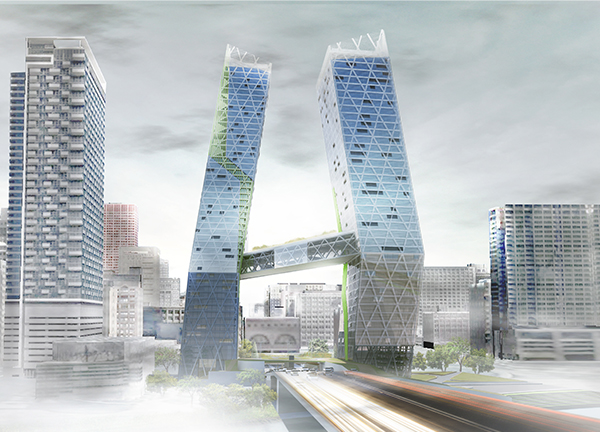Towards Zero Carbon: High-Rise Design within the Chicago Decarbonization Plan
Chicago, IL, United States | 2012
 “CO2ngress Gateway Towers” by Danny Mui and Benjamin Sahagun, create a bridge over the corridor that filters air and fuels a new breed of car for its residents.
“CO2ngress Gateway Towers” by Danny Mui and Benjamin Sahagun, create a bridge over the corridor that filters air and fuels a new breed of car for its residents.
This comprehensive design studio aimed to address three important questions: What if we could tap into Chicago’s latent potential by using the built environment as a carbon asset?; What if we could redefine energy as a commodity to be traded between buildings, blocks, cities?; and What if we could transform Chicago’s Loop into a net carbon-positive district? Using the framework of the DeCarbonization Plan, the design studio seeked to design tall buildings which are positive additions to the city’s skyline visually, urbanistically, and environmentally. Students were in pairs, and each pair worked with tutors to establish a unique set of environmental Key Performance Indicators (KPIs) - a set of quantifiable goals which drove the design. These KPIs allowed students to work toward the goals set in the DeCarbonization Plan. Students also developed unique building programs depending on the location chosen.
The project site was the Wolf Point, Chicago, which is the location at the confluence of the North, South and Main Branches of the Chicago River in the present day Near North Side, Loop, and Near West Side community areas of Chicago. Students were free to determine the size, height, function, accommodation and responsibilities of the building, according to their site study & research. It was possible that the building was mixed-use in nature. Possible influential factors on detailed program (in no particular hierarchy) may be: site area, urban grain, neighbouring buildings, city requirements, community requirements, the commercial market, social responsibility, sustainability, aesthetics, proportions, plot ratios, transit/mobility, infrastructure, etc. Students needed to devise design solutions to respond to the local climatic, social, cultural and financial conditions.
Get the Latest News and Updates from CTBUH
Fields with an asterisk (*) next to them are required.
View our privacy policy
